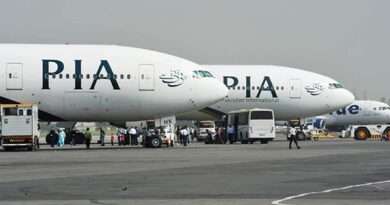Gold Prices Hit Record High in Pakistan, Forex Reserves Drop Due to Debt Repayments
|
Getting your Trinity Audio player ready...
|
Introduction: The Record-Breaking Surge of Gold Prices in Pakistan
In an unprecedented rise, gold prices in Pakistan have surged to an all-time high, with the price per tola reaching an astonishing Rs291,800. This marks a significant milestone in Pakistan’s precious metals market, as gold prices saw an unprecedented increase of Rs3,100 in a single day. This surge mirrors a similar upward movement in the global gold markets, pushing the yellow metal to new heights. In addition to this, Pakistan’s foreign exchange reserves have taken a hit, seeing a decline of $76 million due to external debt repayments, leading to a slight depreciation in the rupee.
Gold Price Surge in Pakistan: The All-Time High
Gold Prices Soar to Rs291,800 Per Tola
As of Thursday, gold prices in Pakistan reached their highest-ever level, with the price of gold per tola increasing by Rs3,100 to settle at Rs291,800. This sharp rise follows a similar trend seen in international markets, where gold prices have also been climbing steadily. According to the All-Pakistan Gems and Jewellers Sarafa Association (APGJSA), this is the highest price for gold ever recorded in the country.
The Intraday Jump and Global Influences
Initially, the price of gold climbed by Rs1,600 per tola, reaching Rs290,300 before surging further to its record-breaking price of Rs291,800. This marks a dramatic increase in just one day. Prior to this, the price had already risen by Rs2,300 per tola on Wednesday, with prices hitting Rs288,700.
The international gold market also mirrored these gains, experiencing a two-step rise in prices. Gold initially increased by $15 per ounce, reaching $2,778, followed by another climb of $14 to close at $2,792 per ounce. This upward trajectory in the global market has supported the growth in local gold prices.
The Role of Global Economic Factors
The Impact of US Inflation Data and Global Tariff Threats
Gold’s rally can be largely attributed to the uncertain global economic environment. The looming threat of tariffs, coupled with inflationary pressures in the US, has kept investors wary, driving them toward gold as a safe-haven asset. As market sentiment remains uncertain, investors are flocking to gold, pushing prices to new heights.
Adnan Agar, the Director of Interactive Commodities, pointed out that gold’s current trajectory is backed by strong support levels. He noted that $2,730 per ounce is a key support level, and as long as this holds, gold is expected to continue climbing, with short-term fluctuations likely before the market stabilizes.
Institutional Selling and Investor Behavior
Institutional selling has also played a key role in sustaining the market’s bullish trend. Despite 40% of investors holding loss-making positions, the market remains strong. This reflects a widespread belief that gold will continue to outperform other assets in the face of economic uncertainties.
Future Outlook for Gold Prices
Anticipating a Possible Correction
Though gold prices are experiencing a strong rally, experts caution that the upside potential may be limited. According to Agar, gold prices are likely to test the $2,800–$2,810 range before a potential correction takes place. This correction is expected to be a short-term pullback of $30–$40 per ounce, after which the market is expected to stabilize.
US Inflation Data and Its Impact on Gold Prices
The upcoming US inflation data, particularly the Consumer Price Index (CPI) report, will be a crucial factor influencing gold prices in the coming days. A weaker US dollar has been instrumental in supporting gold prices, and as long as this trend continues, gold prices are expected to maintain their upward trajectory.
Pakistan’s Foreign Exchange Reserves: A Decline Amid Economic Pressures
Foreign Exchange Reserves Fall Due to Debt Repayments
Meanwhile, Pakistan’s economic situation remains under strain. The State Bank of Pakistan (SBP) reported a significant decline of $76 million in foreign exchange reserves, bringing the total reserves to $11.37 billion as of January 24, 2025. This drop is primarily attributed to external debt repayments, which continue to pressure the country’s financial stability.
Liquid Foreign Exchange Reserves
Pakistan’s total liquid foreign exchange reserves now stand at $16.05 billion. This includes the reserves held by commercial banks, which remain at $4.68 billion. Despite these liquid reserves, the ongoing pressure on the country’s financial stability has led to a weakening of the rupee.
Pakistani Rupee Depreciates Slightly
The Pakistani rupee saw a slight depreciation against the US dollar, weakening by 0.02% in the inter-bank market on Thursday. The currency closed at 278.97 per dollar, down by 4 paisa from the previous session. This decline in the rupee is indicative of the broader economic challenges facing Pakistan as it grapples with debt repayments and the need for financial stability.
Impact of Gold Price Surge on Pakistan’s Economy
Gold as a Safe-Haven Asset for Investors
As gold prices reach record highs, they continue to attract investors seeking safe-haven assets amid economic uncertainty. This surge in gold prices provides an opportunity for investors in Pakistan to safeguard their wealth. However, the high price of gold may also limit its affordability for some sections of the population, leading to reduced demand for physical gold.
Potential Effects on Inflation and Consumer Behavior
The surge in gold prices could have indirect effects on inflation in Pakistan, as higher gold prices may lead to increased costs for gold-related goods and services. Additionally, the rising price of gold may prompt consumers to reassess their spending habits and seek alternative forms of investment.
Conclusion: A Period of Uncertainty for Pakistan’s Economy and Gold Market
As gold prices continue to soar to new heights, the global and local economic landscape remains in flux. The weakening US dollar and inflation concerns, coupled with tariff threats and external debt repayments, have created a perfect storm for the gold market. While investors continue to view gold as a safe-haven asset, Pakistan’s economic challenges, including declining foreign exchange reserves and a weakening rupee, pose significant risks to the country’s financial stability.
FAQs
1. Why did gold prices rise in Pakistan? Gold prices in Pakistan surged due to a combination of global inflationary pressures, tariff threats, and a weakening US dollar. This led to increased demand for gold as a safe-haven asset.
2. What is the current price of gold per tola in Pakistan? As of Thursday, the price of gold per tola in Pakistan reached a record high of Rs291,800.
3. How do global economic factors affect gold prices? Global factors such as inflation, interest rates, currency fluctuations, and geopolitical uncertainties influence gold prices. A weakening US dollar and inflationary pressures have helped push gold prices higher.
4. Will gold prices continue to rise? While gold prices are expected to maintain an upward trajectory, experts predict a possible short-term correction before the market stabilizes. Future movements will depend on factors like US inflation data and market sentiment.
5. How is Pakistan’s economy affected by the rise in gold prices? The rise in gold prices may lead to increased inflation and could affect consumer behavior in Pakistan. Additionally, the country’s economic challenges, including declining foreign exchange reserves and a weakening rupee, add to the uncertainty




